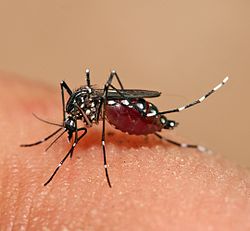13
May
Fish and Wildlife Service Adopts Biological Mosquito Management
(Beyond Pesticides, May 13, 2014) After pressure from environmental organizations, the U.S. Fish and Wildlife Service (FWS) dropped plans to spray the synthetic insecticide methoprene in favor of a biological control material to kill mosquitoes breeding on a national wildlife refuge on the southern Oregon Coast. Several states have banned methoprene due to the chemical’s environmental impacts. The unfolding of this decision illustrates that least-toxic alternatives to manage mosquitos are effective and much safer for the environment.
A major restoration at the Bandon Marsh National Wildlife Refuge in 2011 inadvertently created a number of shallow water pools, a perfect habitat for mosquito larvae. Unprecedented swarms of mosquitoes appeared last year, which drove away campers from Bullards Beach State Park and harassed golfers at local courses. FWS did not take into  account that this restoration project could create mosquito habitat and initially released a plan to manage mosquitos with methoprene and mineral oil.
account that this restoration project could create mosquito habitat and initially released a plan to manage mosquitos with methoprene and mineral oil.
The insect conservation group Xerces Society, the Center for Food Safety, and others urged the agency to reconsider, arguing the pesticides were a threat to the food chain and the mosquitoes, Aedes dorsalis, did not spread human diseases such as West Nile virus. In a supplemental environmental assessment last month, the agency agreed to use the biological pesticide Bacillus thuringiensis israelensis, known as Bti.
“After evaluating public comments”‰…”‰and discussion with mosquito experts, the Service determined that using Bti will effectively control mosquitoes on the Ni-les’tun Unit while posing a low risk to wildlife, their habitats, and the human environment,” FWS said in a statement.
Methoprene is an insect growth regulator that prevents development to the adult reproductive stages so that insects die in arrested immaturity. It is an insecticide that is acutely toxic to estuarine invertebrates, including valuable food and commercial species like crabs and lobsters. Methoprene has a tendency to sink to the bottom of the ocean water, where crabs and lobsters live and feed. Additionally, lobsters are a distant cousin of mosquitoes, and the methoprene acts on them in much the same way that it does the insects.
Some states have limited the use of methoprene because of its toxic effects on aquatic life. Last summer Connecticut Governor Dannel Malloy signed into law House Bill 6441, which banned methoprene and resmethrin in coastal areas such as the Long Island Sound. Declines in the Sound’s lobster population have been alarmingly common for the past 15 years, devastating fishermen and the local economy that depends on them. Connecticut legislators say that they were convinced that banning the two mosquito pesticides after learning that Rhode Island and Massachusetts had enacted similar bans with successful results. A similar bill to ban the use of methoprene was also introduced in Sufolk County, New York last summer.
As mosquito season begins again, take action in your community to advocate for safer and effective options in dealing with mosquitoes and insect-borne diseases. The ideal mosquito management strategy eschews chemical controls like methoprene, and employs an integrated approach that emphasizes education, aggressive removal of standing water sources, larval control, monitoring, and surveillance for both mosquito-borne illness and pesticide-related illness. Beyond Pesticides advises communities to adopt a preventive, health-based mosquito management plan, and has several resource publications on the issue, including the Public Health Mosquito Management Strategy: For Decision Makers and Communities. Visit Beyond Pesticides’ West Nile Virus/Mosquito Management for more details.
Source: The Register-Guard
All unattributed positions and opinions in this piece are those of Beyond Pesticides.










